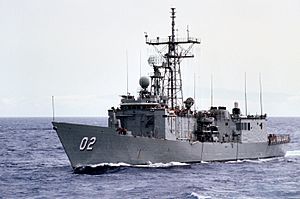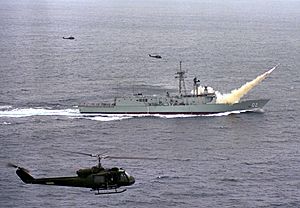HMAS Canberra (FFG 02) facts for kids

HMAS Canberra in 1988
|
|
Quick facts for kids History |
|
|---|---|
| Namesake | City of Canberra |
| Builder | Todd Pacific Shipyards, Seattle, Washington |
| Laid down | 1 March 1978 |
| Launched | 1 December 1978 |
| Commissioned | 21 March 1981 |
| Decommissioned | 12 November 2005 |
| Motto | "For Queen And Country" |
| Nickname(s) | FFG-18 (US hull designation during construction) |
| Honours and awards |
|
| Fate | Sunk as dive wreck 4 October 2009 |
| General characteristics | |
| Class and type | Adelaide-class guided missile frigate |
| Displacement | 4,100 tons |
| Length | 138.1 m (453 ft) overall |
| Beam | 13.7 m (45 ft) |
| Draught | 7.5 m (25 ft) |
| Propulsion |
|
| Speed | 29 knots (54 km/h; 33 mph) |
| Range | 4,500 nautical miles (8,300 km; 5,200 mi) at 20 knots (37 km/h; 23 mph) |
| Complement | 184 (including 15 officers, not including aircrew) |
| Sensors and processing systems |
|
| Armament |
|
| Aircraft carried | 2 × S-70B Seahawk or 1 × Seahawk and 1 × AS350B Squirrel |
HMAS Canberra (FFG 02) was a special type of warship called a guided missile frigate. It belonged to the Royal Australian Navy (RAN). Canberra was part of the Adelaide class of ships.
This ship was built in the United States. It was one of four Adelaide class ships made there. Two more were built in Australia, making a total of six for the RAN.
Canberra started its service in 1981. It had many important jobs. It escorted the Royal Yacht Britannia during Queen Elizabeth II's visit in 1988. It also helped make sure rules were followed after the Gulf War.
Later, it helped during riots in Indonesia in 1998. It also assisted during the Solomon Islands Civil War in 2000. In 2002, Canberra went to the Persian Gulf to support efforts in the War in Afghanistan.
In 2005, Canberra was taken out of service. It was the first ship of its kind to be decommissioned. The ship was later sunk on purpose to become a dive wreck and an artificial reef. This happened on October 4, 2009, near Barwon Heads, Victoria.
Contents
Building a Warship: HMAS Canberra
After some plans for new destroyers were cancelled, Australia looked for other options. They decided on the American Oliver Hazard Perry class frigates. These ships were still being designed at the time.
Australia chose this design because it was easier to add certain missiles. Also, previous American ship designs had worked well for Australia. So, in 1976, Australia ordered two of these frigates, including Canberra.
Two more were ordered later, and then two more were built in Australia. This made a total of six Adelaide class ships for the RAN.
When first built, Canberra weighed about 3,605 tons. It was about 135.6 meters (445 feet) long. It was 13.7 meters (45 feet) wide.
Later, the ship was updated and made a bit longer. This made it 138.1 meters (453 feet) long. Its weight increased to 4,100 tons.
The ship was powered by two large gas turbines. These engines gave it a lot of power, about 41,000 horsepower. This allowed the ship to travel at a top speed of 29 knots (about 54 km/h or 33 mph). It could travel 4,500 nautical miles (about 8,300 km) at a slower speed.
For moving slowly, like in a harbor, it had two smaller electric propellers. These could move the ship at about 4 knots. The ship usually had a crew of 184 people, including officers.
Weapons and Equipment
Canberra had many weapons to protect itself and complete its missions. Its main weapon was a Mark 13 missile launcher. This launcher could fire two types of missiles:
- Harpoon missiles, used against other ships.
- Standard missiles, used against aircraft.
It also had a 76 mm (3 inch) gun on the front of the ship. For close-range defense, it had a 20 mm Phalanx CIWS system. This system could shoot down incoming missiles or aircraft very quickly.
For fighting submarines, Canberra had two Mark 32 torpedo launchers. These fired torpedoes that could track and hit submarines underwater.
The ship could also carry up to six 12.7 mm (0.50 caliber) machine guns. Sometimes, it had two special remote-controlled machine guns called Mini Typhoons.
Canberra was also equipped with advanced sensors. These included:
- A radar system to search for aircraft far away.
- A radar system for finding ships and for navigation.
- A sonar system to detect objects underwater, like submarines.
The ship could carry two helicopters. Usually, these were S-70B Seahawk helicopters. Sometimes, it carried one Seahawk and one smaller AS350B Squirrel helicopter.
Canberra was built by Todd Pacific Shipyards in Seattle, Washington. It was started on March 1, 1978, and launched on December 1, 1978. The ship officially joined the Royal Australian Navy on March 21, 1981.
Canberra's Missions and Service
After joining the navy, Canberra and another ship, Adelaide, stayed in the United States for training. They worked with the United States Navy during this time.
In 1988, Canberra had a special job. It escorted the Royal Yacht Britannia when Queen Elizabeth II visited Australia. This was part of Australia's 200th birthday celebrations.
In May 1990, Canberra was one of many warships from 21 countries. They gathered for a Royal Fleet Review in Malaysia. This event celebrated the 55th anniversary of the Royal Malaysian Navy.
From November 1992 to March 1993, Canberra was sent to the Red Sea. Its mission was to help enforce the United Nations' rules against Iraq after the Gulf War.
In December 1993, Canberra visited Malaysia and New Zealand. In Malaysia, its divers helped police find a missing sailor. In New Zealand, the ship was present for Waitangi Day. This day celebrates an important treaty in New Zealand's history.
In February 1996, Canberra's home base changed. It moved from New South Wales to Western Australia.
In May 1998, Canberra was ready to help. It was one of four Australian ships on standby to evacuate Australians from Indonesia. This was due to riots happening there.
After the Solomon Islands Civil War ended in 2000, Canberra was the last Australian warship sent there. It supported the International Peace Monitoring Team from September to October 2001.
In January 2002, Canberra went to Heard Island and McDonald Islands. It helped enforce Australia's laws about fishing in these areas. During this trip, it caught a Russian fishing boat that was fishing illegally.
Later that year, Canberra joined other Australian ships in the Persian Gulf. They supported the International Coalition Against Terrorism in the War in Afghanistan.
In July 2003, Canberra intercepted a suspected illegal entry vessel. This was the first such interception since December 2001.
Canberra was officially taken out of service on November 12, 2005. This happened at its home base in Western Australia.
Becoming a Dive Site
In October 2006, it was announced that Canberra would be sunk on purpose. The goal was to create a wreck diving site off the coast of Barwon Heads, Victoria.
The Australian government provided A$2.8 million for the project. The Victorian government added A$500,000. Later, more federal money was given to speed up the process.
The plan was to sink the frigate in 30 meters (98 feet) of water. This spot was about 2 nautical miles (3.7 km) off Ocean Grove, Victoria. The sinking was first planned for September 13, 2009. However, bad weather caused a delay.
On October 4, 2009, sixteen special charges were used to sink the ship. This happened at 2 PM, after a six-hour delay in getting the ship into position. Divers checked the ship the next day to make sure it had settled safely.
The wreck was opened to the public for diving on December 5. Four mooring points were installed for dive boats. Safety checks and repairs were also completed.
In early 2011, a warning was issued. Part of the ship's hangar had separated. In mid-2011, the dive site was closed due to safety concerns. After more checks, the site was reopened on October 24, 2011.
In March 2010, Canberra received a special honor. It was given the "Persian Gulf 2002" battle honor. This was for its service during the War in Afghanistan.


